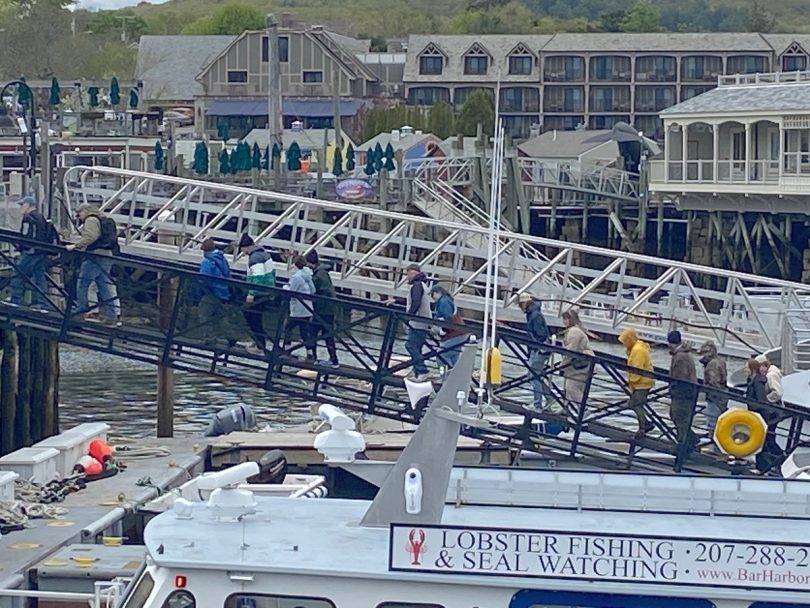With the unofficial start of Bar Harbor’s tourism season just days away, local business owners are apprehensive about what 2025 might bring.
The scenic seaside town on Mount Desert Island, which serves as a gateway to Acadia National Park, has attracted seasonal visitors for more than a century but this year is expected to present myriad challenges for the businesses and organizations that cater to tourists.
President Donald Trump’s bellicose diplomacy could deter foreign tourists from coming, and his administration’s efforts to sharply reduce the federal budget could mean that more jobs at Acadia go unfilled — an obstacle that in recent years has also been caused by a lack of affordable housing in the area.
But while those potential hurdles have yet to play out, one thing is for sure: there will be far fewer cruise ship visits in Bar Harbor this year than usual — a result of strict limits that local voters approved in 2022 and upheld again last fall. Approximately 70 ships that carry more than 1,000 passengers visited the town last year, but this year only 17 such ships are expected to drop anchor in Frenchman Bay, with the first not expected until the end of August.
“Without the spring cruise ships, I’m definitely feeling it,” takeout business owner Robin Wright said. She owns Downeast Deli, Downeast Pizza and Pink Pastry Shop, which typically have relied heavily on cruise ship visits in the spring to help her pay bills.
“They reached into my checkbook and took out 30 percent,” she said of the decision to sharply reduce cruise ship traffic.
Kevin DesVeaux, co-owner of West Street Cafe, said he also is pessimistic about how his summer will play out. He said cruise ship passengers typically have made up 35 percent of his business, and that the looming tariffs have pushed up his food costs.
“Don’t forget the Canadians!” he said, adding that he has yet to see any in his restaurant yet this spring. Canadians often visit Maine in the summer, but tariff threats and other controversial statements from Trump have chilled the cross-border relationship.
“Not a great start to the season,” DesVeaux said. “The changing business landscape has made independent establishments, such as our own, difficult to continue. We simply don’t have the resources to lose money year after year and remain open!”
More than 70 cruise ship visits are expected in Bar Harbor this summer, but more than 40 are by ships that carry roughly 200 or fewer passengers, and so are not subject to the new 1,000-passenger daily limit pushed through by voters, which is being challenged in court. There are 14 visits scheduled by ships that each carry roughly between 500 and 900 passengers.
Ships with more than 1,000 passengers that are still on Bar Harbor’s schedule were booked before voters approved the new limits, and are being honored by town officials out of concern that canceling them could result in even more legal challenges.
As voters in Bar Harbor and Portland push back on cruise ship visits, other towns have offered their ports as alternate Maine destinations.
Pearl Mist, a smaller ship that carries 210 passengers, had been expected to visit Bar Harbor on May 9, but opted to spend the day instead in Eastport, which is expected to get 17 cruise ship visits this summer and fall. Cruise ships have typically started showing up in Bar Harbor in late April or early May but with that cancellation, no ships are expected to visit Bar Harbor until the 100-passenger American Independence cruises into Frenchman Bay on June 3.
Outside the COVID years of 2020 and 2021, when the cruise industry ground to a halt and no such ships appeared off MDI, the most recent year that Bar Harbor had fewer than 20 large ship visits was in 1989.
Gary “Bo” Jennings, who manages Side Street Cafe and other affiliated hospitality businesses, said that despite the reduced cruise ship schedule and the impact of potential tariffs, advance bookings for local hotels are strong, even though numbers statewide were down 9 percent last year. April was “solid” but May has been slower, most likely because of rainy weekends that have deterred people elsewhere in Maine and New England from visiting, said Jennings, who also serves as president of the local Chamber of Commerce.
“We’ve been pleased with the turnout so far,” he said.
He echoed concerns about reduced cruise ship visits, saying he has hired fewer people to work lunch shifts at the cafe this spring, and that the looming tariffs have made restaurant equipment more expensive. He said that the number of people who visit Acadia post-COVID is likely to remain historically high, in the 3.9 million range, but that Bar Harbor could end up getting less of that business if hotel development eventually is restricted and more tourists opt to stay in Ellsworth or other nearby towns.
“Acadia will get the same visitation,” he said. “But Bar Harbor won’t necessarily.”
In addition to the cost of doing business, there also is concern about how Acadia might be affected by federal layoffs being pursued by the Trump administration.
Eric Stiles, president of the nonprofit advocacy group Friends of Acadia, said that he and other park supporters are waiting to see how the National Park Service will be affected by the steep cuts that they expect.
He said Acadia and other parks got approval to fill seasonal positions earlier this year, but that even just the threat of layoffs have prompted many long-term National Park Service employees to leave — and that a hiring freeze is preventing the park service from filling those vacancies.
Case in point, he said, is the departure earlier this year of Acadia’s certified water system operator at Schoodic Point, where a former Navy base has been converted into a research and education campus within the park.
The employee’s departure put the entire operation of the facility, which is operated by the nonprofit Schoodic Institute, at jeopardy, Stiles said. But in a stroke of fortitude and luck, the institute found and hired a previous operator who had managed the system for the Navy, circumventing the service’s hiring freeze and keeping the program running.
The volatility of pressuring year-round National Park Service employees to leave, and not allowing their vacancies to be filled, threatens to undermine the complex process by which Acadia and other sites are staffed, maintained and operated — which in turn underpins the surrounding economy that serves and makes money off park visitors, Stiles said. For Acadia, that economy generates nearly $700 million a year in the Down East region, he said.
Stiles said he supports making government more efficient and cost effective, but he compared the current approach to asking a mechanic to fix a car with a sledgehammer.
“The level of people leaving the National Park Service is unprecedented,” Stiles said. “It increases the risk of failure.”
Wright said that, while her downtown Bar Harbor businesses were “pounded” during the COVID years and yet managed to survive, it is hard to remain optimistic about the future. To address a chronic labor shortage, she has adapted by keeping an immigration lawyer on retainer so she can hire foreign visa workers. She has also acquired residential properties for her employees to address the housing shortage, but is not sure her businesses will survive with a steep cut in cruise ship traffic.
There may be a silver lining or some way her businesses can adjust, she said, but she won’t know until late October.
“The numbers don’t lie,” she said. “We’ll see at the end of the season.”










